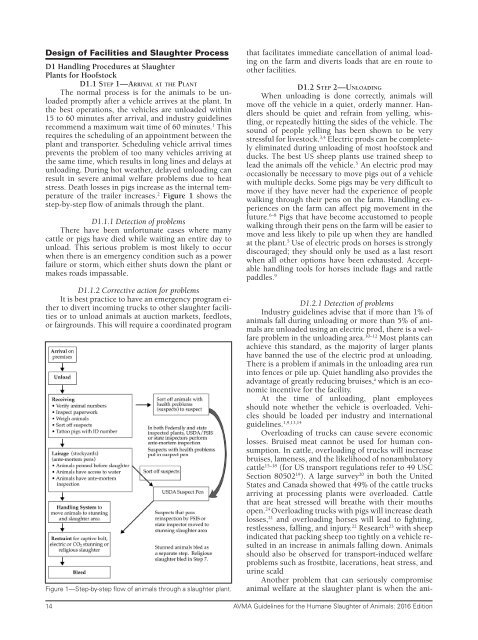Humane-Slaughter-Guidelines
You also want an ePaper? Increase the reach of your titles
YUMPU automatically turns print PDFs into web optimized ePapers that Google loves.
Design of Facilities and <strong>Slaughter</strong> Process<br />
D1 Handling Procedures at <strong>Slaughter</strong><br />
Plants for Hoofstock<br />
D1.1 Step 1—Arrival at the Plant<br />
The normal process is for the animals to be unloaded<br />
promptly after a vehicle arrives at the plant. In<br />
the best operations, the vehicles are unloaded within<br />
15 to 60 minutes after arrival, and industry guidelines<br />
recommend a maximum wait time of 60 minutes. 1 This<br />
requires the scheduling of an appointment between the<br />
plant and transporter. Scheduling vehicle arrival times<br />
prevents the problem of too many vehicles arriving at<br />
the same time, which results in long lines and delays at<br />
unloading. During hot weather, delayed unloading can<br />
result in severe animal welfare problems due to heat<br />
stress. Death losses in pigs increase as the internal temperature<br />
of the trailer increases. 2 Figure 1 shows the<br />
step-by-step flow of animals through the plant.<br />
D1.1.1 Detection of problems<br />
There have been unfortunate cases where many<br />
cattle or pigs have died while waiting an entire day to<br />
unload. This serious problem is most likely to occur<br />
when there is an emergency condition such as a power<br />
failure or storm, which either shuts down the plant or<br />
makes roads impassable.<br />
D1.1.2 Corrective action for problems<br />
It is best practice to have an emergency program either<br />
to divert incoming trucks to other slaughter facilities<br />
or to unload animals at auction markets, feedlots,<br />
or fairgrounds. This will require a coordinated program<br />
Figure 1—Step-by-step flow of animals through a slaughter plant.<br />
that facilitates immediate cancellation of animal loading<br />
on the farm and diverts loads that are en route to<br />
other facilities.<br />
D1.2 Step 2—Unloading<br />
When unloading is done correctly, animals will<br />
move off the vehicle in a quiet, orderly manner. Handlers<br />
should be quiet and refrain from yelling, whistling,<br />
or repeatedly hitting the sides of the vehicle. The<br />
sound of people yelling has been shown to be very<br />
stressful for livestock. 3,4 Electric prods can be completely<br />
eliminated during unloading of most hoofstock and<br />
ducks. The best US sheep plants use trained sheep to<br />
lead the animals off the vehicle. 5 An electric prod may<br />
occasionally be necessary to move pigs out of a vehicle<br />
with multiple decks. Some pigs may be very difficult to<br />
move if they have never had the experience of people<br />
walking through their pens on the farm. Handling experiences<br />
on the farm can affect pig movement in the<br />
future. 6–8 Pigs that have become accustomed to people<br />
walking through their pens on the farm will be easier to<br />
move and less likely to pile up when they are handled<br />
at the plant. 5 Use of electric prods on horses is strongly<br />
discouraged; they should only be used as a last resort<br />
when all other options have been exhausted. Acceptable<br />
handling tools for horses include flags and rattle<br />
paddles. 9<br />
D1.2.1 Detection of problems<br />
Industry guidelines advise that if more than 1% of<br />
animals fall during unloading or more than 5% of animals<br />
are unloaded using an electric prod, there is a welfare<br />
problem in the unloading area. 10–12 Most plants can<br />
achieve this standard, as the majority of larger plants<br />
have banned the use of the electric prod at unloading.<br />
There is a problem if animals in the unloading area run<br />
into fences or pile up. Quiet handling also provides the<br />
advantage of greatly reducing bruises, a which is an economic<br />
incentive for the facility.<br />
At the time of unloading, plant employees<br />
should note whether the vehicle is overloaded. Vehicles<br />
should be loaded per industry and international<br />
guidelines. 1,9,13,14<br />
Overloading of trucks can cause severe economic<br />
losses. Bruised meat cannot be used for human consumption.<br />
In cattle, overloading of trucks will increase<br />
bruises, lameness, and the likelihood of nonambulatory<br />
cattle 15–18 (for US transport regulations refer to 49 USC<br />
Section 80502 19 ). A large survey 20 in both the United<br />
States and Canada showed that 49% of the cattle trucks<br />
arriving at processing plants were overloaded. Cattle<br />
that are heat stressed will breathe with their mouths<br />
open. 24 Overloading trucks with pigs will increase death<br />
losses, 21 and overloading horses will lead to fighting,<br />
restlessness, falling, and injury. 22 Research 23 with sheep<br />
indicated that packing sheep too tightly on a vehicle resulted<br />
in an increase in animals falling down. Animals<br />
should also be observed for transport-induced welfare<br />
problems such as frostbite, lacerations, heat stress, and<br />
urine scald<br />
Another problem that can seriously compromise<br />
animal welfare at the slaughter plant is when the ani-<br />
14 AVMA <strong>Guidelines</strong> for the <strong>Humane</strong> <strong>Slaughter</strong> of Animals: 2016 Edition



